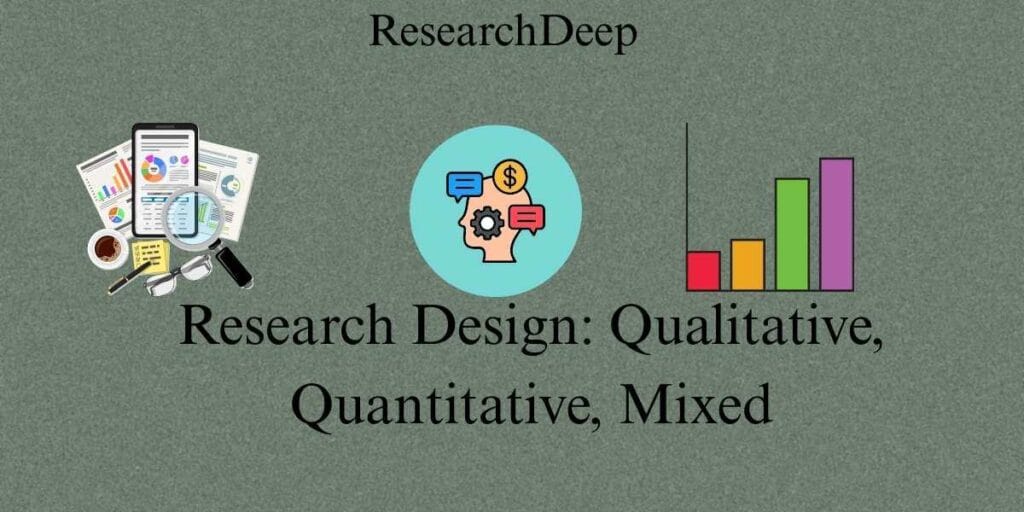Last updated on October 2nd, 2025 at 12:31 pm
Introduction
Research design serves as the blueprint of a study, guiding researchers in selecting an appropriate type of research to collect, analyze, and interpret data. Among the most widely used research designs are qualitative, quantitative, and mixed methods.
Each has distinct strengths and applications, and the choice often depends on the research problem, objectives, and discipline (Creswell & Creswell, 2018).
This article defines research design, qualitative, quantitative, and mixed methods, and identifies their key characteristics, strengths, and limitations to assist in selecting the most suitable for your research question.
Table of Contents
What is research Design?
A research design provides the overall plan for a study. It ensures methodological accuracy, minimizes bias, and aligns data collection with research objectives.
The three primary approaches—qualitative, quantitative, and mixed—reflect different philosophical assumptions and strategies.
Research Design: Qualitative, Quantitative & Mixed
Explores experiences and meanings using non-numerical data.
Uses numerical data and statistical analysis to test hypotheses.
Combines qualitative depth with quantitative breadth for holistic insights.
Qualitative Research Design
Definition
Qualitative research explores phenomena through non-numerical data such as interviews, focus groups, and observations. It aims to understand experiences, meanings, and social processes (Denzin & Lincoln, 2017).
Key Characteristics
- Focuses on exploration and description.
- Uses open-ended data collection methods.
- Relies on interpretive analysis.
Strengths
- Provides an in-depth understanding of human behavior.
- Captures contextual and cultural nuances.
- Flexible and adaptable to emerging findings.
Limitations
- Subjective interpretation may introduce bias.
- Findings are often not generalizable.
Quantitative Research Design
Definition
Quantitative research involves the systematic collection of numerical data to test hypotheses and establish relationships between variables (Creswell, 2014).
Key Characteristics
- Utilizes structured tools, including surveys, experiments, and tests.
- Data is analyzed using statistical methods.
- Seeks objectivity, reliability, and replicability.
Strengths
- Enables statistical generalization.
- Provides measurable and comparable results.
- Facilitates hypothesis testing.
Limitations
- May overlook contextual factors.
- Often, it is less flexible once data collection begins.
Mixed Methods Research Design
Definition
Mixed methods research integrates both qualitative and quantitative approaches in a single study, aiming to draw on the strengths of both (Creswell & Plano Clark, 2017).
Key Characteristics
- Collects both numerical and narrative data.
- Often conducted in sequential or concurrent phases.
- Provides a comprehensive understanding of the research problem.
Strengths
- Combines breadth (quantitative) with depth (qualitative).
- Cross-validates results through triangulation.
- Useful for complex research questions.
Limitations
- More resource-intensive (in terms of time, expertise, and cost).
- Requires proficiency in both qualitative and quantitative methods.
📊 Comparison of Research Design Qualitative Quantitative And Mixed Methods
| Feature | Qualitative Research | Quantitative Research | Mixed Methods Research |
|---|---|---|---|
| Primary Goal | Explore meanings, experiences, and social processes. | Test hypotheses, measure variables, and establish relationships. | Combine exploration with measurement for holistic insight. |
| Data Type | Non-numerical (interviews, observations, texts) | Numerical (surveys, experiments, statistics) | Both narrative and numerical. |
| Approach | Inductive (theory emerges from data) | Deductive (tests existing theories) | Integrates both inductive and deductive |
| Analysis | Thematic, narrative, discourse analysis. | Statistical, mathematical, computational. | Mixed analysis (statistical + thematic) |
| Strengths | In-depth, contextual, flexible. | Objective, replicable, generalizable. | Comprehensive, cross-validates findings. |
| Limitations | May lack generalizability, subjective. | May miss context, less flexible. | Resource-intensive, requires multi-skilled expertise. |
| Common Use | Social sciences, psychology, anthropology. | Natural sciences, economics, and health sciences. | Education, public health. |
Choosing Between Qualitative, Quantitative & Mixed
Selecting the right research design is not a one-size-fits-all decision. It depends on several interrelated factors that shape the study’s direction and feasibility.
1. Research Question
The type of research question largely determines the design:
- Exploratory questions (e.g., “How do doctoral students cope with academic stress?”) are best suited to qualitative designs, as they aim to uncover experiences, perceptions, and underlying processes.
- Explanatory or causal questions (e.g., “Does a new teaching intervention improve student test scores?”) align with quantitative designs, as they require measurement, statistical analysis, and hypothesis testing.
- Integrative questions (e.g., “How effective is a new curriculum, and how do students perceive it?”) are ideal for mixed methods, which provide both measurable outcomes and contextual insights.
2. Nature of Data Needed
The kind of data that answers the research question dictates the design:
- Narrative or descriptive data (stories, opinions, behaviors) → suited for qualitative research.
- Numerical data (percentages, correlations, test scores) → suited for quantitative research.
- Combination of both (e.g., survey scores supported by interviews) → suited for mixed methods research.
3. Practical Constraints
Practical realities often influence the choice:
- Time: Longitudinal quantitative studies may take years, while a small-scale qualitative analysis can be completed faster.
- Funding: Experimental studies often need expensive equipment or large samples, whereas qualitative studies may require fewer resources.
- Expertise: Mixed-methods research demands researchers who are skilled in both statistical analysis and qualitative interpretation, which may not always be feasible.
Example Case Study
Case Study: Evaluating a New Mental Health Intervention for University Students
Research Question: Does the intervention reduce student stress levels, and how do students perceive its effectiveness?
Design: Mixed methods.
Nature of Data Needed:
Quantitative → Standardized stress scale scores before and after the intervention.
Qualitative → In-depth interviews capturing students’ experiences, challenges, and suggestions.
Practical Constraints:
- Funding is required for licensed psychological assessment tools.
- Time constraints are due to stress levels that fluctuate during exam periods.
- Need for both a statistician (for data analysis) and a qualitative researcher (for thematic coding).
Why Mixed Methods?
The quantitative data provide measurable evidence of the intervention’s effectiveness, while qualitative insights reveal why it worked (or didn’t) and how it can be improved.
Without integrating both, the study would lack either statistical rigor or contextual depth.
FAQs: Research Designs
What is the main difference between qualitative and quantitative research designs?
Qualitative research focuses on exploring meanings and experiences using non-numerical data, while quantitative research relies on numerical data and statistical analysis to test hypotheses (Creswell).
Why use a mixed methods research design?
Mixed methods design allows researchers to combine the strengths of qualitative depth with quantitative generalizability, providing a more holistic perspective (Creswell & Plano Clark, 2017).
What research design is most suitable for the social sciences?
Social sciences often benefit from qualitative or mixed methods, as they allow for interpretation of human behavior, culture, and context (Denzin & Lincoln, 2017).
Conclusion
Research design forms the foundation of any scholarly inquiry by ensuring that the study is methodologically sound, reliable, and aligned with its objectives. Among the three principal approaches—qualitative, quantitative, and mixed methods—each offers unique strengths and is best suited to specific types of research questions.
- Qualitative research excels in exploring lived experiences, social contexts, and meanings that cannot be reduced to numbers.
- Quantitative research provides precision, replicability, and generalizability through statistical analysis.
- Mixed methods research bridges the gap between the two, combining depth with breadth to offer a holistic perspective on complex problems.
Choosing the right design is not simply a theoretical exercise; it requires balancing the research question, type of data needed, and practical constraints such as time, funding, and expertise. In many cases, researchers find that mixed methods provide the most comprehensive answers, particularly in fields where human experiences intersect with measurable outcomes.
A well-matched design ensures reliable, valid, and impactful results.
References
Creswell, J. W. (2009). Research designs. Qualitative, quantitative, and mixed methods approaches.
- Creswell, J. W. (2014). Research Design: Qualitative, Quantitative, and Mixed Methods Approaches (4th ed.). Sage Publications.
- Creswell, J. W., & Creswell, J. D. (2018). Research Design: Qualitative, Quantitative, and Mixed Methods Approaches (5th ed.). Sage Publications.
- Creswell, J. W., & Plano Clark, V. L. (2017). Designing and Conducting Mixed Methods Research (3rd ed.). Sage Publications.
- Denzin, N. K., & Lincoln, Y. S. (2017). The Sage Handbook of Qualitative Research (5th ed.). Sage Publications.



